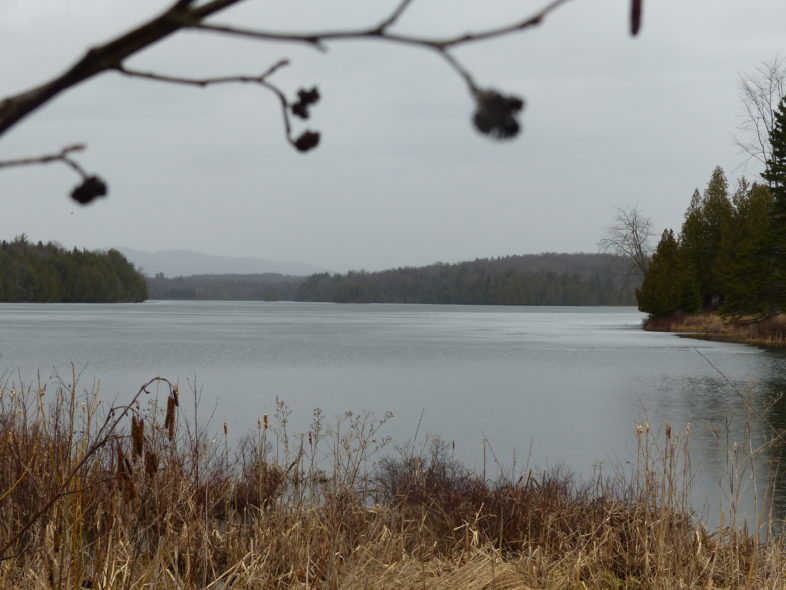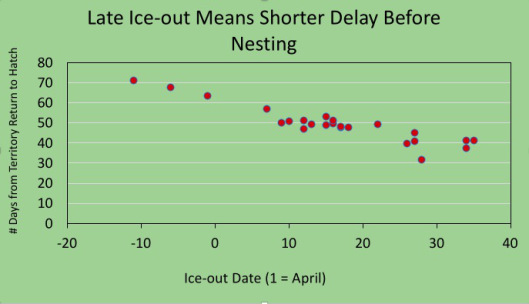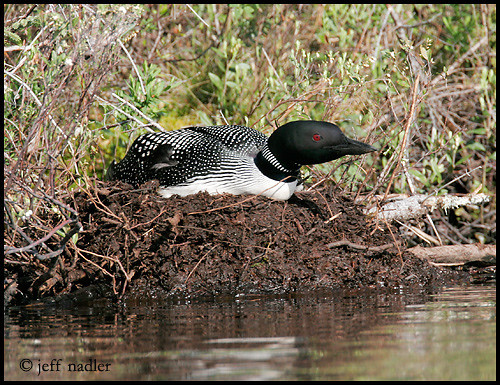
Open water finally appeared on Little Hosmer Pond in Craftsbury on 4/27/18
(10-15 days later than average). Photo by Eric Hanson.
Late February’s spring-like weather fooled many into thinking they could dig out their spring birding checklists and maybe even plant peas on Town Meeting Day. But then Old Man Winter came back like the curmudgeon he is, and overstayed his welcome. Vermont’s lakes and ponds sealed back up with ice, and those in the north country remained frozen solid into the early days of May.
How do these late ice-out dates affect our Common Loons? In April, loons return to scout out their territory, which requires open water since these birds cannot land on solid surfaces, like ice (or land). In May, they mate, build their nests, and lay eggs. So, what happens when they return to find their lakes are still solid? In late ice-out years past, reports of loons flying over frozen lakes, seemingly running reconnaissance, were common. In Craftsbury, where I live, lakes are still frozen nearly solid, yet I heard a loon on April 27. Let’s hope these scouting loons have the energy to join their comrades congregating on open lakes further south and east, or on slow-moving rivers, waiting for the chance to take up residence on more suitable habitat.
Ice-out and Nest Dates
Dr. Walter Piper of Chapman University in California and his team of researchers have followed color-banded loons in Wisconsin for over 20 years. Dr. Piper recently posted a blog on his website (www.loonproject.org) that includes an analysis of the effect of ice-out dates on loon nesting dates. His results show that nesting does occur slightly later when the ice sticks around longer, but the difference is not dramatic, and does not seem to affect chick productivity at the end of the year. Piper stated, “when the ice goes out early, loons dawdle and wait weeks before nesting. But when the ice goes out late, as it will this year, pairs get down to business quickly, (often) nesting within a week or so of territory return. So loon pairs are somehow able to catch up in years of late ice-out so that their breeding schedule does not differ greatly from other years.”

Dr. Walter Piper compared the number of days between territory return and hatching to ice-out date. Left side of graph are early ice-outs; right side is late ice-outs. Graph credit: www.loonproject.org
As distressing as it may be for us to see returning loons circling frozen lakes in search of a place to land, loons innately know that they they must “wait it out” on available, open water bodies in years when spring comes later than we all would like.

Common Loon on a nest. / © Jeff Nadler

Hello,
The common lions on out lake Tabor Lake near Danbury in NW Wisconsin is still on the nest as of 7/13/19.
We’re wondering if they will hatch or what will happen. Any ideas from the experts?? I’d love to let the lake association know what’s up.
Thanks
Greg Bauer
612-910-5970
It is common for some loon pairs to still be incubating into mid and even late July. These are often re-nests after a failed nest in early June. In Vermont, we had some first nest attempts this year starting after June 20. Most loons initiate nesting between May 20 and June 15, thus chicks start appearing June 15-July 10 with some on either end of this time frame.